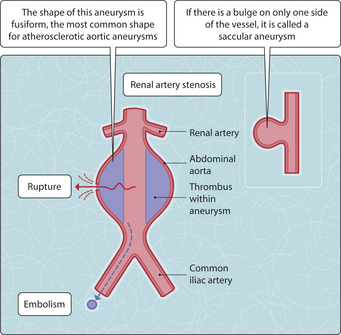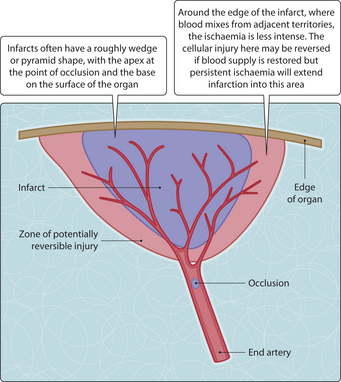Chapter 36 Consequences of atherosclerosis and their risk factors
The importance of atherosclerosis stems from the serious conditions that can result, principally ischaemic heart disease, cerebral infarction, peripheral vascular disease and aortic aneurysm. Ischaemic heart disease is covered in Ch. 35.
Cerebral infarction
The arteries of the brain are functional end-arteries: that is, the tissue they supply receives blood from that artery alone because the anastomoses between arteries are insufficient to allow for collateral blood supply. As a result, occlusion can cause infarction of the territory supplied by the artery (Fig. 3.36.1). This event can cause a stroke (i.e. sudden cerebral dysfunction owing to a vascular event in the brain). Atherosclerosis is the commonest cause of cerebral infarction, either by embolism from a ruptured plaque or by thrombotic occlusion of an atherosclerotic segment (see also Ch. 57).
Aortic aneurysms
Atherosclerotic aneurysms occur most frequently in the abdominal aorta, but they can also affect the common iliac arteries and the thoracic aorta. The typical abdominal aortic aneurysm is located between the renal arteries and the aortic bifurcation and is partially filled with thrombus. Complications include obstruction of the ostia of branches of the aorta (e.g. the renal or mesenteric arteries), embolism of thrombotic debris from the aneurysm, and rupture through the weakened wall (Fig. 3.36.2). Rupture is a life-threatening event because of the severe haemorrhage that results; it becomes a significant risk when the aneurysm exceeds 5cm in diameter and, therefore, surgical repair is likely to be considered in patients who have an aneurysm of this size.

Fig. 3.36.2 A typical aneurysm of the aorta in longitudinal section, showing possible complications.
Stay updated, free articles. Join our Telegram channel

Full access? Get Clinical Tree







